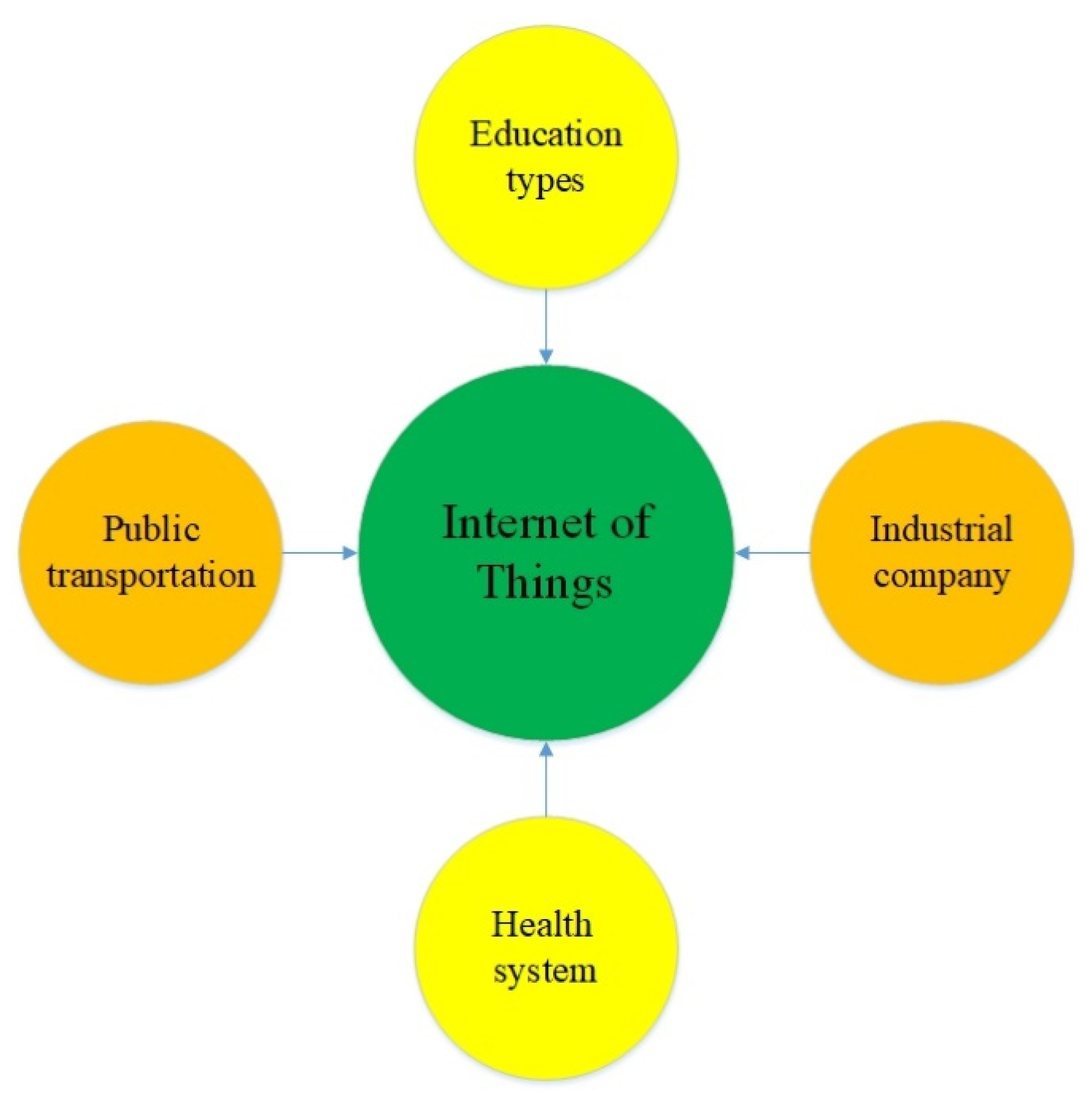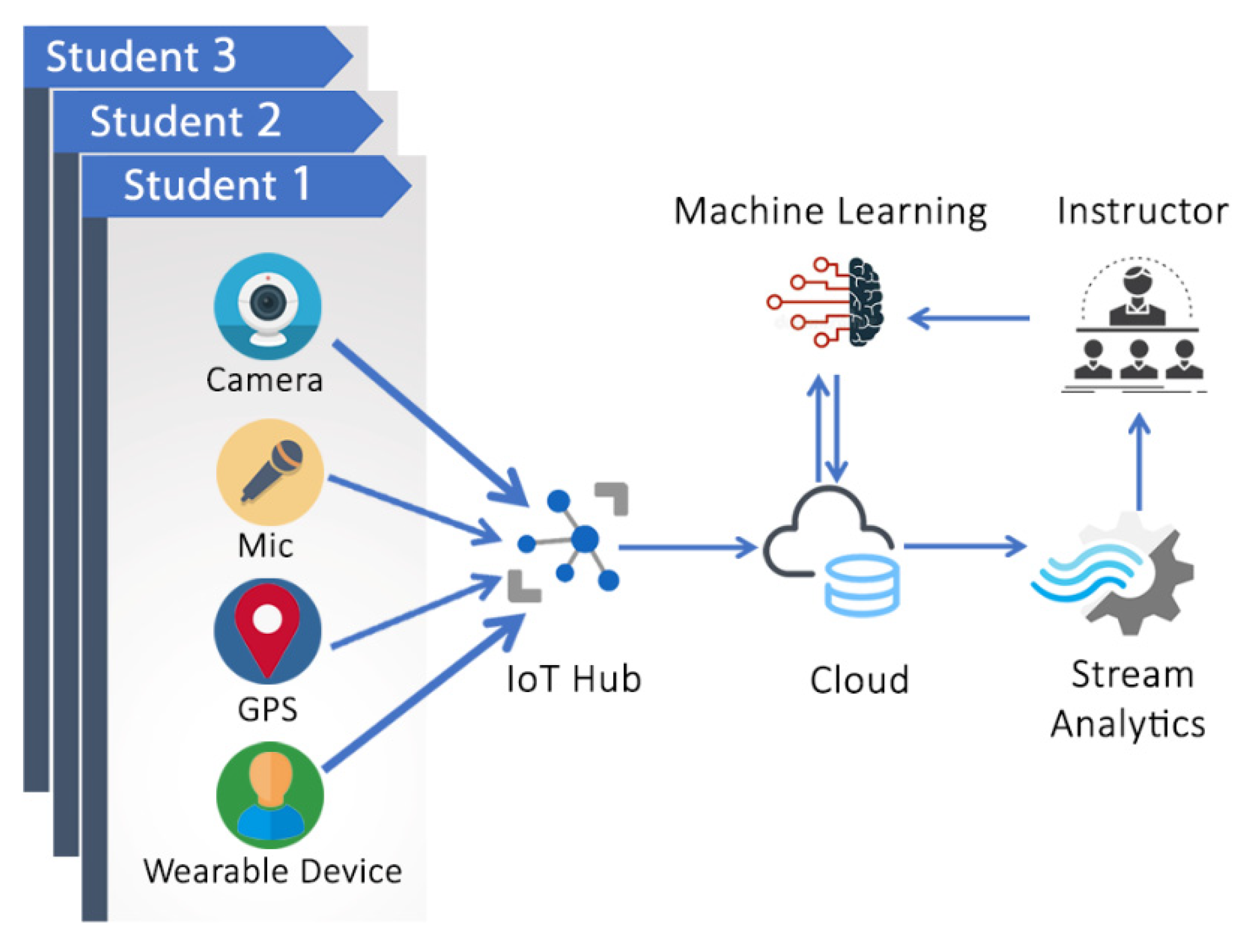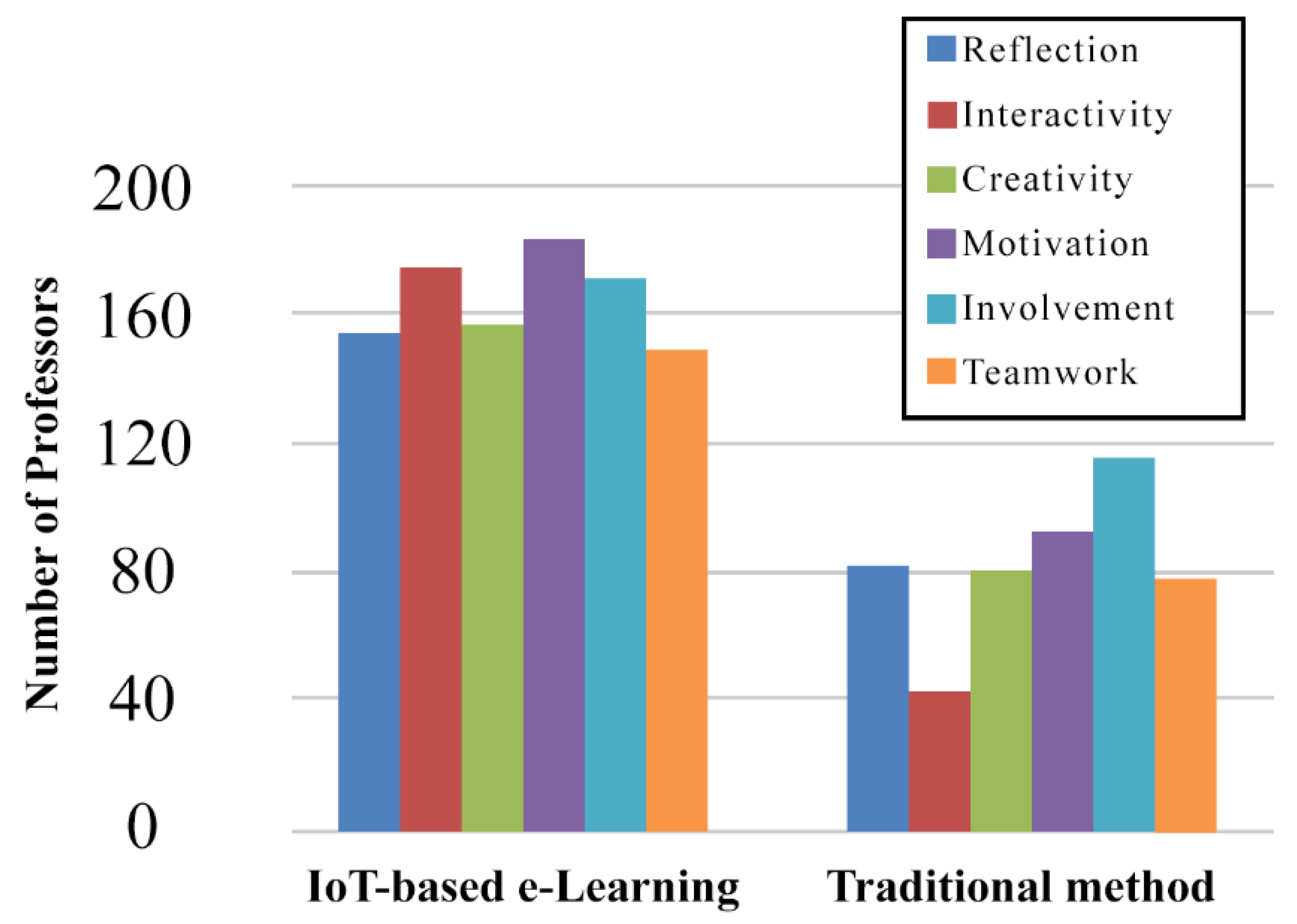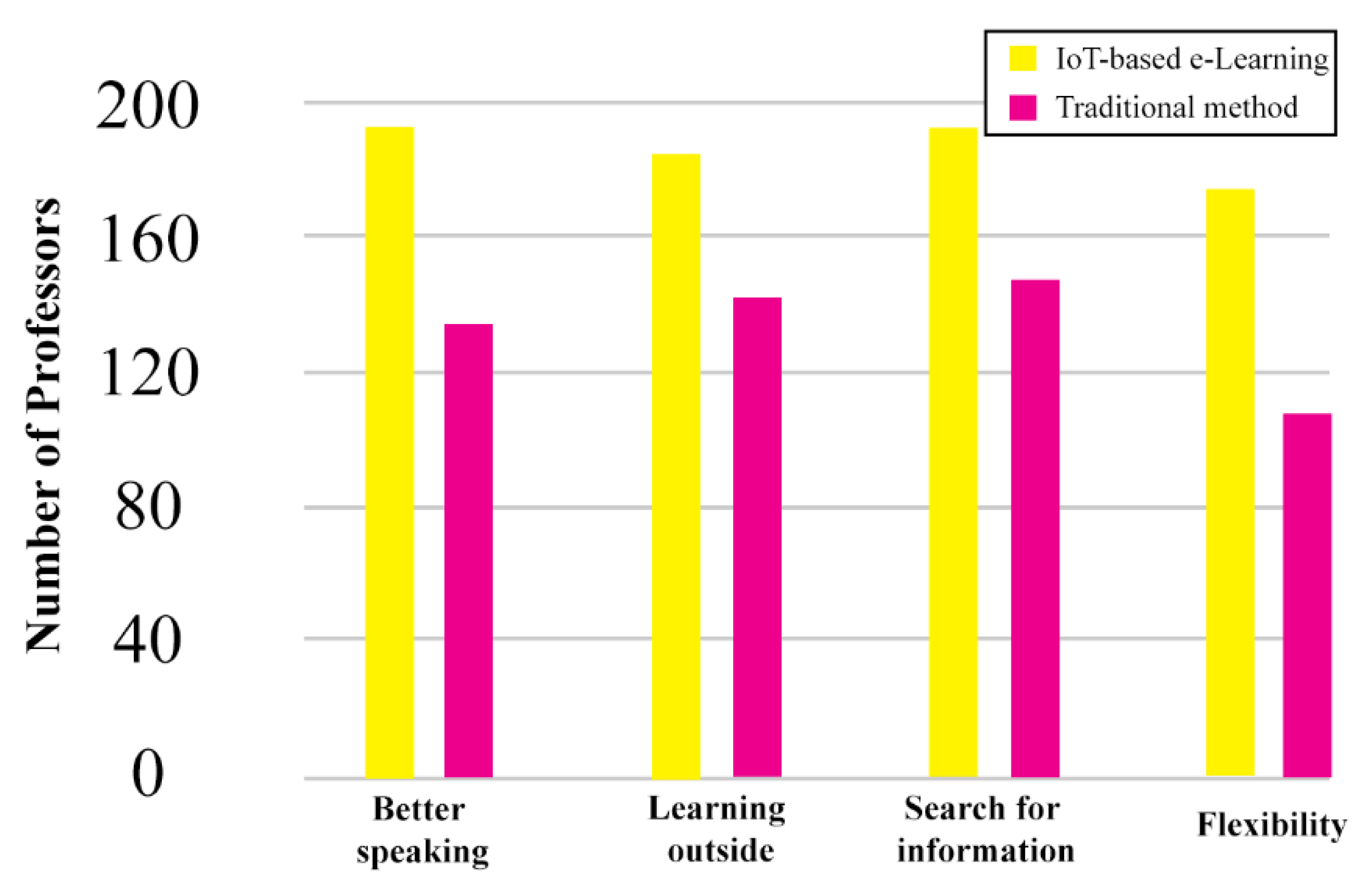E-Learning Development Based on Internet of Things and Blockchain Technology during COVID-19 Pandemic
Abstract
:1. Introduction
- Providing a practical framework for IoT-based e-learning;
- Determining the impact of the IoT on e-learning systems;
- Evaluating the performance of the IoT-based education process through a questionnaire.
2. Literature Review
3. Proposed Method
3.1. Problem Statement
3.2. IoT e-Learning
- ✓
- Existence of intelligent interactive class.
- ✓
- Increase students’ creativity by using updated tools.
- ✓
- Comprehensive reporting of student activities.
- ❖
- Reduce costs by communicating directly and without intermediaries with the customer.
- ❖
- Reduce the risk of accidents by providing trust between IoT devices.
- ❖
- Accelerate real-time transactions.
3.3. IoT for Examinations
3.4. Data Collection
4. Performance Assessment
5. Conclusions and Future Work
Author Contributions
Funding
Institutional Review Board Statement
Informed Consent Statement
Data Availability Statement
Conflicts of Interest
References
- Fu, Y.; Zhang, C.; Chen, Y.; Gu, F.; Baležentis, T.; Streimikiene, D. Ordered weighted logarithmic averaging distance-based pattern recognition for the recommendation of traditional Chinese medicine against COVID-19 under a complex environment. Kybernetes 2021. [Google Scholar] [CrossRef]
- Galanakis, C.M. The food systems in the era of the Coronavirus (COVID-19) pandemic crisis. Foods 2020, 9, 523. [Google Scholar] [CrossRef]
- Hidalgo, G.I.; Sánchez-Carracedo, F.; Romero-Portillo, D. COVID-19 Emergency remote teaching opinions and academic performance of undergraduate students: Analysis of 4 students’ profiles: A case study. Mathematics 2021, 9, 2147. [Google Scholar] [CrossRef]
- Gardas, B.B.; Navimipour, N.J. Performance evaluation of higher education system amid COVID-19: A threat or an opportunity? Kybernetes 2021. [Google Scholar] [CrossRef]
- Kausar, S.; Huahu, X.; Ullah, A.; Wenhao, Z.; Shabir, M.Y. Fog-assisted secure data exchange for examination and testing in E-learning system. Mob. Netw. Appl. 2020, 1–17. [Google Scholar] [CrossRef]
- Furini, M.; Galli, G.; Martini, M.C. An online education system to produce and distribute video lectures. Mob. Netw. Appl. 2019, 25, 969–976. [Google Scholar] [CrossRef]
- Bekesiene, S.; Vasiliauskas, A.; Hošková-Mayerová, Š.; Vasilienė-Vasiliauskienė, V. Comprehensive assessment of distance learning modules by fuzzy AHP-TOPSIS method. Mathematics 2021, 9, 409. [Google Scholar] [CrossRef]
- Fadda, E.; Perboli, G.; Tadei, R. Customized multi-period stochastic assignment problem for social engagement and opportunistic IoT. Comput. Oper. Res. 2018, 93, 41–50. [Google Scholar] [CrossRef] [Green Version]
- Sadrishojaei, M.; Navimipour, N.J.; Reshadi, M.; Hosseinzadeh, M. A new preventive routing method based on clustering and location prediction in the mobile Internet of things. IEEE Internet Things J. 2021, 8, 10652–10664. [Google Scholar] [CrossRef]
- Sadrishojaei, M.; Navimipour, N.J.; Reshadi, M.; Hosseinzadeh, M. Clustered routing method in the Internet of things using a moth-flame optimization algorithm. Int. J. Commun. Syst. 2021, 34, e4964. [Google Scholar] [CrossRef]
- Sadrishojaei, M.; Navimipour, N.J.; Reshadi, M.; Hosseinzadeh, M. A new clustering-based routing method in the mobile internet of things using a krill herd algorithm. Clust. Comput. 2021, 1–11. [Google Scholar] [CrossRef]
- Sadrishojaei, M.; Navimipour, N.J.; Reshadi, M.; Hosseinzadeh, M.; Unal, M. An energy-aware clustering method in the IoT using a swarm-based algorithm. Wirel. Netw. 2021, 1–12. [Google Scholar] [CrossRef]
- Alhasan, A.; Audah, L.; Ibrahim, I.; Al-Sharaa, A.; Al-Ogaili, A.S.; Mohammed, J.M. A case-study to examine doctors’ intentions to use IoT healthcare devices in Iraq during COVID-19 pandemic. Int. J. Pervasive Comput. Commun. 2020. [Google Scholar] [CrossRef]
- Amasha, M.A.; Areed, M.F.; Alkhalaf, S.; Abougalala, R.A.; Elatawy, S.M.; Khairy, D. The future of using Internet of things (loTs) and context-aware technology in E-learning. In Proceedings of the 9th International Conference on Educational and Information Technology, Oxford, UK, 11–13 February 2020. [Google Scholar]
- Zaharov, A.A.; Nissenbaum, O.V.; Ponomarov, K.Y.; Shirokih, A.V. Use of open-source Internet of things platform in education projects. In Proceedings of the 2018 Global Smart Industry Conference (GloSIC), Chelyabinsk, Russia, 13–15 November 2018; pp. 1–6. [Google Scholar]
- Mohamed, F.; Abdeslam, J.; Lahcen, E.B. Towards new approach to enhance learning based on Internet of things and virtual reality. In Proceedings of the International Conference on Big Data and Internet of Thing—BDIOT2017, Beijing, China, 24–26 October 2018; p. 54. [Google Scholar]
- Yang, Y.; Yu, K. Construction of distance education classroom in architecture specialty based on internet of things technology. Int. J. Emerg. Technol. Learn. 2016, 11, 56–61. [Google Scholar] [CrossRef] [Green Version]
- Vharkute, M.; Wagh, S. An architectural approach of internet of things in E-Learning. In Proceedings of the 2015 International Conference on Communications and Signal Processing (ICCSP), Chengdu, China, 10–11 October 2015; pp. 1773–1776. [Google Scholar]
- Cornel, C.-E. The role of internet of things for a continuous improvement in education. Hyperion Econ. J. 2015, 2, 24–31. [Google Scholar]
- Abbasy, M.B.; Quesada, E.V. Predictable Influence of IoT (Internet of Things) in the higher education. Int. J. Inf. Educ. Technol. 2017, 7, 914–920. [Google Scholar] [CrossRef] [Green Version]
- Zahedi, M.H.; Dehghan, Z. Effective E-learning utilizing Internet of things. In Proceedings of the 13th Iranian and 7th National Conference on e-Learning and e-Teaching (ICeLeT), Tehran, Iran, 20–21 February 2019; pp. 1–6. [Google Scholar]
- Ying, L.; Jiong, Z.; Wei, S.; Jingchun, W.; Xiaopeng, G. VREX: Virtual reality education expansion could help to improve the class experience (VREX platform and community for VR based education). In Proceedings of the IEEE Frontiers in Education Conference (FIE), Indianapolis, IN, USA, 18–21 October 2017; pp. 1–5. [Google Scholar]
- Lin, H.C.-S.; Yu, S.-J.; Sun, J.C.-Y.; Jong, M.S.Y. Engaging university students in a library guide through wearable spherical video-based virtual reality: Effects on situational interest and cognitive load. Interact. Learn. Environ. 2019, 1–16. [Google Scholar] [CrossRef]
- Chicharro, F.I.; Giménez, E.; Sarría, Í. The enhancement of academic performance in online environments. Mathematics 2019, 7, 1219. [Google Scholar] [CrossRef] [Green Version]
- Elyamany, H.F.; AlKhairi, A.H. IoT-academia architecture: A profound approach. In Proceedings of the IEEE/ACIS 16th International Conference on Software Engineering, Artificial Intelligence, Networking and Parallel/Distributed Computing (SNPD), Takamatsu, Japan, 1–3 June 2015. [Google Scholar]
- Aldowah, H.; Rehman, S.U.; Ghazal, S.; Umar, I. Internet of things in higher education: A study on future learning. J. Phys. Conf. Ser. 2017, 892, 012017. [Google Scholar] [CrossRef]
- Chen, G.; Xu, B.; Lu, M.; Chen, N.-S. Exploring blockchain technology and its potential applications for education. Smart Learn. Environ. 2018, 5, 1. [Google Scholar] [CrossRef] [Green Version]
- Dorri, A.; Kanhere, S.S.; Jurdak, R. Blockchain in internet of things: Challenges and solutions. arXiv 2016, arXiv:1608.05187. [Google Scholar]
- Khalid, S.; Hwang, H.; Kim, H.S. Real-world data-driven machine-learning-based optimal sensor selection approach for equipment fault detection in a thermal power plant. Mathematics 2021, 9, 2814. [Google Scholar] [CrossRef]
- Reyes-Campos, J.; Alor-Hernández, G.; Machorro-Cano, I.; Olmedo-Aguirre, J.; Sánchez-Cervantes, J.; Rodríguez-Mazahua, L. Discovery of resident behavior patterns using machine learning techniques and IoT paradigm. Mathematics 2021, 9, 219. [Google Scholar] [CrossRef]
- Clark, A.Y.; Blumenfeld, N.; Lal, E.; Darbari, S.; Northwood, S.; Wadpey, A. Using K-means cluster analysis and decision trees to highlight significant factors leading to homelessness. Mathematics 2021, 9, 2045. [Google Scholar] [CrossRef]
- Olague, H.M.; Etzkorn, L.H.; Gholston, S.; Quattlebaum, S. Empirical validation of three software metrics suites to predict fault-proneness of object-oriented classes developed using highly iterative or agile software development processes. IEEE Trans. Softw. Eng. 2007, 33, 402–419. [Google Scholar] [CrossRef]
- Al-Okaily, M.; Alqudah, H.; Matar, A.; Lutfi, A.; Taamneh, A. Dataset on the acceptance of E-learning system among universities students’ under the COVID-19 pandemic conditions. Data Brief. 2020, 32, 106176. [Google Scholar] [CrossRef] [PubMed]




| Mechanism | Approach | Advantage | Weakness |
|---|---|---|---|
| Yang and Yu [17] | ZigBee/GPRS wireless network technology system for e-learning |
|
|
| Vharkute and Wagh [18] | Combines different applications of e-learning with the help of the IoT |
|
|
| Cornel [19] | IoT-based methodology for establishing online virtual labs |
|
|
| Abbasy and Quesada [20] | IoT on higher education, including theoretical analysis and a statistical investigation |
|
|
| Zahedi and Dehghan [21] | IoT-based e-learning in various aspects |
|
|
| Ying, Jiong [22] | Virtual Reality-based Education eXpansion training platform |
|
|
| Lin, Yu [23] | Wearable spherical video-based virtual reality |
|
|
| Attributes | Property | Value | Percentage (%) |
|---|---|---|---|
| Gender | Male | 191 | 68.21 |
| Female | 89 | 31.79 | |
| Age | <23 | 50 | 17.85 |
| 23–29 | 102 | 36.42 | |
| 29-35 | 85 | 30.35 | |
| >35 | 43 | 15.35 | |
| Education rate | Undergraduate | 104 | 37.14 |
| Graduate | 176 | 62.86 |
| Variables | Items | Scale | |
|---|---|---|---|
| Flexibility | F1 | The IoT-based e-learning allows me to organize my teaching time. | 1 (Completely disagree) 2 (Disagree) 3 (No comment) 4 (Agree) 5 (Completely agree) |
| F2 | The IoT-based e-learning allows me to have complete control over my education. | ||
| F3 | My learning environment is flexible. | ||
| Learning experience | LE1 | A teacher has trained me to learn remotely. | |
| LE2 | I have been trained in effective e-learning. | ||
| LE3 | Students are happy to be taught with this model. | ||
| Educational productivity | EP1 | I am an effective student. | |
| EP2 | I am satisfied with the quality of our IoT-based e-learning. | ||
| EP3 | I train efficiently. | ||
| EP4 | I am a very active student. | ||
| EP5 | My teacher believes that I am an active student. | ||
| EP6 | Among the students in the class, I rank my performance in the upper half of the course. | ||
| E-learning | DL1 | Do a lot of homework daily during IoT-based e-learning. | |
| DL2 | IoT-based e-learning allows me to be more effective. | ||
| DL3 | IoT-based e-learning is an efficient model for education. | ||
| Quality of education | QoE1 | I am satisfied with the educational opportunities available at the IoT-based e-learning. | |
| QoE2 | My learning time is commensurate with my living conditions. | ||
| QoE3 | My learning environment is stable. | ||
| QoE4 | When I am learning, I forget what is happening around me. | ||
| Constructs | Items | λ | VIF | AVE | CR | CA |
|---|---|---|---|---|---|---|
| Flexibility (F) | F1 | 0.903 | 2.141 | 0.537 | 0.814 | 0.729 |
| F2 | 0.899 | 1.897 | ||||
| F3 | 0.871 | 2.019 | ||||
| Learning experience (LE) | LE1 | 0.834 | 1.513 | 0.585 | 0.736 | 0.723 |
| LE2 | 0.752 | 1.631 | ||||
| LE3 | 0.834 | 1.207 | ||||
| Educational productivity (EP) | EP1 | 0.876 | 1.403 | 0.707 | 0.839 | 0.724 |
| EP2 | 0.722 | 2.081 | ||||
| EP3 | 0.885 | 1.742 | ||||
| EP4 | 0.783 | 1.859 | ||||
| EP5 | 0.798 | 1.727 | ||||
| EP6 | 0.831 | 1.696 | ||||
| E-learning (EL) | EL1 | 0.733 | 1.551 | 0.677 | 0.814 | 0.762 |
| EL2 | 0.917 | 1.024 | ||||
| EL3 | 0.845 | 1.857 | ||||
| Quality of education (QoE) | QoE1 | 0.873 | 1.438 | 0.633 | 0.805 | 0.712 |
| QoE2 | 0.892 | 1.207 | ||||
| QoE3 | 0.811 | 1.376 | ||||
| QoE4 | 0.837 | 1.484 |
| F | LE | EP | EL | QoE | |
|---|---|---|---|---|---|
| Flexibility | 0.735 | ||||
| Learning experience | 0.592 | 0.747 | |||
| Educational productivity | 0.504 | 0.539 | 0.711 | ||
| E-learning | 0.396 | 0.461 | 0.595 | 0.741 | |
| Quality of education | 0.407 | 0.363 | 0.505 | 0.589 | 0.847 |
Publisher’s Note: MDPI stays neutral with regard to jurisdictional claims in published maps and institutional affiliations. |
© 2021 by the authors. Licensee MDPI, Basel, Switzerland. This article is an open access article distributed under the terms and conditions of the Creative Commons Attribution (CC BY) license (https://creativecommons.org/licenses/by/4.0/).
Share and Cite
Rahmani, A.M.; Ali Naqvi, R.; Hussain Malik, M.; Malik, T.S.; Sadrishojaei, M.; Hosseinzadeh, M.; Al-Musawi, A. E-Learning Development Based on Internet of Things and Blockchain Technology during COVID-19 Pandemic. Mathematics 2021, 9, 3151. https://doi.org/10.3390/math9243151
Rahmani AM, Ali Naqvi R, Hussain Malik M, Malik TS, Sadrishojaei M, Hosseinzadeh M, Al-Musawi A. E-Learning Development Based on Internet of Things and Blockchain Technology during COVID-19 Pandemic. Mathematics. 2021; 9(24):3151. https://doi.org/10.3390/math9243151
Chicago/Turabian StyleRahmani, Amir Masoud, Rizwan Ali Naqvi, Mazhar Hussain Malik, Tauqeer Safdar Malik, Mahyar Sadrishojaei, Mehdi Hosseinzadeh, and Ali Al-Musawi. 2021. "E-Learning Development Based on Internet of Things and Blockchain Technology during COVID-19 Pandemic" Mathematics 9, no. 24: 3151. https://doi.org/10.3390/math9243151
APA StyleRahmani, A. M., Ali Naqvi, R., Hussain Malik, M., Malik, T. S., Sadrishojaei, M., Hosseinzadeh, M., & Al-Musawi, A. (2021). E-Learning Development Based on Internet of Things and Blockchain Technology during COVID-19 Pandemic. Mathematics, 9(24), 3151. https://doi.org/10.3390/math9243151









